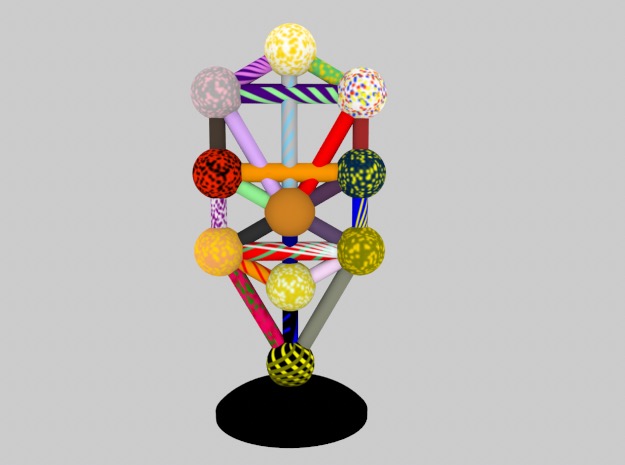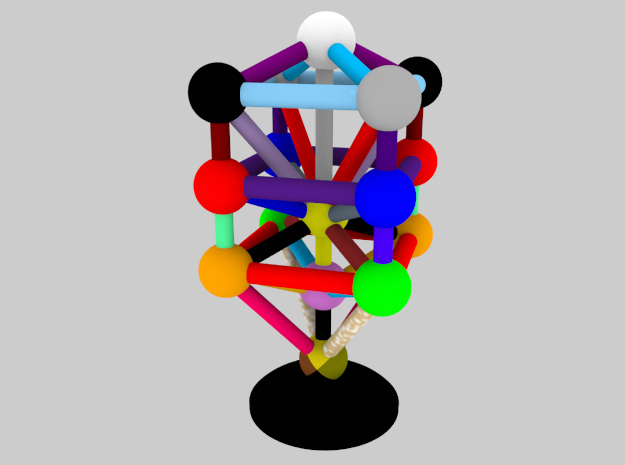I’ve just finished my first color design project for my Shapeways shop, Kickin’ Wiccan. It proved to be challenging in ways I did not expect.
My goal was to create a full-color three-dimensional model of the Tree of Life. For anyone not familiar with the Tree of Life, it’s the best-known design from the Jewish mystical interpretation of the Bible, the Qabalah (or Qabala or Kabalah or Qabalah or Kaballah, etc., depending on how you Anglicize the Hebrew spelling). The Tree of Life has a basic shape that’s easy to build in a 3D program from simple spheres and cylinders:

That’s not the full story. Each element of the Tree of Life, both the spheres and the paths that connect them, have strictly-defined colors according the Qabalah. Here’s the same model with those colors, as best as I could apply them:

Why “as best as I could apply them?” Because the descriptions of the colors of the Tree of Life are far from simple. In my 3D modeling program Cheetah3D, I set the colors with the same hexadecimal codes used for web graphics. I can look up those codes for basic colors; e.g., the code for emerald is “#50c878”. It’s not as easy to look up the color “Purple tinged blue”.
You may notice that the path in the lower right of the picture looks mottled. That’s because its color description is “buff flecked silver-white”. There’s no simple web code for that! So I had to learn about how to apply textures to shapes in Cheetah3D. And I had to learn how to use my 2D graphics tools, Pixelmator and Graphic, to design those textures.
Why “textures” in the plural? Because the colors shown in the above Tree of Life are not the only ones. There are four “color scales” of the Tree of Life, corresponding to the four Qabalistic worlds: the King scale, the Queen scale, the Prince scale, and the Princess scale. The most commonly-used one is the Queen scale, but Qabalah experts use all four. I couldn’t consider the project done until I could make all four color scales available in my Shapeways shop. Here are the other three scales: King, Prince, and Princess.



These scales posed additional challenges. For one thing, the text description of the colors in the Qabalah grow even more exotic: “Reddish gray inclined to mauve”; “Livid indigo brown-black-beetle”. Perhaps a trained colorist can make sense of these descriptions. I had to make choices and go with the best approximations I could see with my limited color training.
The textures grow more complex as well: “White, flecked red, blue, yellow”; “Bright rose or cerise, rayed pale green”. I’m not sure who wrote the colors from their divine visions (tradition says it was the biblical Moses, history says it was a 14th-century fellow named Moses de Leon), but I don’t think they considered the practical challenge of how to draw them.
The textures I’ve created are broad, almost cartoonish. That’s because there’s another issue I had to deal with: using Shapeways’ 3D-printed color sandstone as a medium. The fact that one can 3D-print in color is amazing, and the gamut of available colors is huge. However, the sandstone powder absorbs the color ink, so the effective texture resolution is 50 dots-per-inch. That’s why the texture shapes are so broad. I’d prefer to use tiny dots for flecks and thin lines for rays, but they would not be visible in the actual print.
How did it come out? Here’s the picture from my Shapeways shop:

Here’s my computer model again. Compare the colors.

Close, but not identical. The method I use to specify the colors in my 3D model (RGB, for red-green-blue) is different from the color mechanism used by Shapeways’ 3D sandstone printer (CMYK, for cyan-magenta-yellow-black). The conversion from one format to another can cause color shifts. Also, colors that are close in tone (e.g., the “buff flecked silver-white” path on the lower right) may not be readily distinguishable, especially if they’re shades of brown. To be fair, there are other issues as well: the lighting of the sculpture, both in the 3D software and in the room I took the picture; the color response of the camera in my phone.
Then there’s the complexity of keeping track of 32 colors or textures on four different models, 128 surfaces in all. Even during the course of typing this blog post, I discovered errors and had to correct them. If you’re a master Qabalist, you may be able to spot the mistakes that I had not fixed at the time I made the pictures above. Professional computer modelers do this as a matter of course, but I must resort to guides on the web, with frequent consultations of The Golden Dawn.
These are complex issues. There are people whose entire careers are based on color-matching in different media. Devotees of the Qabalah like precision, and so I’ve tried to be precise, knowing there are limits to my precision. At this point, I have to settle. I’ve done the best I can do with my current set of skills, the tools at hand, and the medium I chose.
I’ve gone even further, and designed a fully 3D interpretation of the Tree of Life, even though no official model exists:


Ten years ago, these tools did not exist; ten years from now they may progress to the point where I can come closer to what the visionaries say they should be. I hope the desire of students of the Qabalah for 3D models of an important image will outweigh the deviations from the ideal. Besides, they can feel superior in knowing that the color of the topmost sphere in the Beriyah world should be “white brilliance” and not merely white.
In the meantime, here are the links to the models in my shop:
Pingback: Kickin’ Wiccan is no more – The Argothald Journal